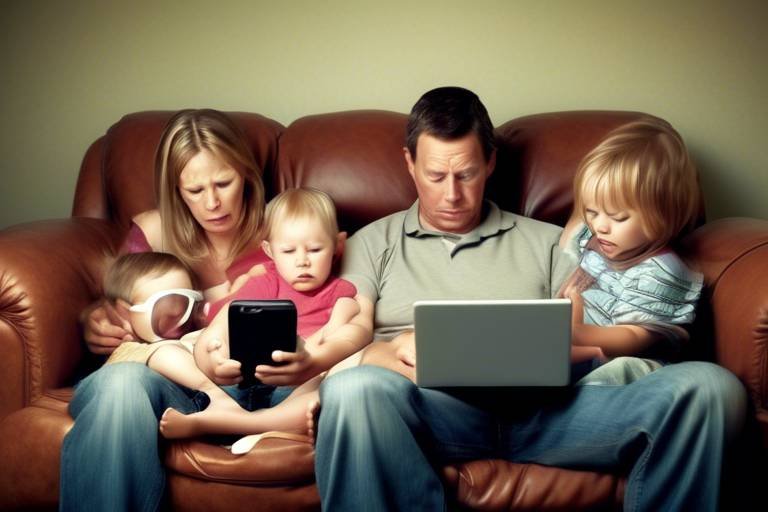The Influence of Social Media on Youth Politics
In today's fast-paced digital world, the influence of social media on youth politics is nothing short of revolutionary. Young people, often the most active users of platforms like Instagram, Twitter, and TikTok, are reshaping how political engagement occurs. Social media has become a powerful tool for **activism**, allowing youth to voice their opinions, share information, and mobilize for change in unprecedented ways. But how exactly does social media shape political views and engagement among the younger generation? Let's dive into this captivating intersection of technology and politics!
Digital activism has transformed how young people engage with politics, allowing them to organize, mobilize, and advocate for causes through online platforms. Imagine a world where a single tweet can spark a global movement—this is the reality we live in today. With just a few clicks, young activists can share their messages, gather support, and create awareness around pressing issues. This new form of activism has made political participation more accessible than ever, breaking down barriers that once limited engagement. Now, anyone with internet access can join the conversation and make their voice heard.
Social media influencers have become pivotal in shaping political conversations among youth. These individuals leverage their platforms to promote political awareness and encourage civic engagement through relatable content. Think of influencers as modern-day town criers, using their reach to inform and mobilize their followers. By sharing personal stories and experiences, they connect with their audience on a deeper level, making complex political issues more digestible and engaging.
One of the most remarkable aspects of social media is the ability for campaigns to go viral. A single post can quickly gain traction, leading to widespread support for a cause. This phenomenon enables youth to rally behind issues that matter to them, often resulting in significant real-world impact. For instance, the viral spread of campaigns related to climate change, racial justice, and mental health awareness showcases how social media can amplify political messages and drive collective action.
Hashtags have become essential tools for youth movements, helping to create a sense of community and urgency around political issues. By using specific hashtags, individuals can easily find and join conversations that resonate with their beliefs. This not only facilitates the spread of information but also fosters a sense of belonging among those who share similar values. For example, hashtags like #YouthVote and #ClimateStrike have united young people across the globe, encouraging them to take action and make their voices heard.
Notable hashtag movements, such as #BlackLivesMatter and #MeToo, illustrate how social media can drive awareness and action among young people. These movements have transcended digital spaces, leading to protests, policy changes, and a broader cultural shift. The collective voices of young activists, amplified through social media, have proven that when united, they can challenge the status quo and demand accountability from those in power.
While social media offers opportunities for engagement, it also presents challenges, particularly the spread of misinformation. In an age where anyone can publish content, distinguishing fact from fiction becomes increasingly difficult. Misinformation can mislead young voters and skew political perceptions, creating confusion and distrust. It's crucial for young people to develop critical thinking skills and digital literacy to navigate this complex landscape effectively.
Online communities have emerged as spaces for youth to discuss political issues, share experiences, and mobilize for change. These digital gathering spots foster a sense of belonging and collective action, allowing young people to connect with like-minded individuals. Whether through Facebook groups, Reddit forums, or Twitter threads, these communities provide a platform for discussion and collaboration, empowering youth to take an active role in shaping their political landscape.
Digital literacy is crucial for youth to navigate the complexities of social media. Understanding how to discern credible information from misinformation is essential for engaging thoughtfully in political discourse. Educational initiatives focusing on digital literacy can equip young people with the skills needed to critically evaluate content and contribute meaningfully to political discussions.
Social media influences how young people interact with traditional political structures. Many young individuals now demand more transparency and responsiveness from political leaders and institutions. They expect to see their concerns addressed in real-time and are less willing to accept the status quo. This shift is pushing politicians to adapt their strategies, recognizing that engaging with youth on social media is no longer optional but essential for political survival.
- How has social media changed political activism?
Social media has made activism more accessible, allowing young people to organize and mobilize quickly for various causes. - What role do influencers play in politics?
Influencers shape political conversations and encourage civic engagement by sharing relatable content and personal stories. - What are the dangers of misinformation?
Misinformation can mislead young voters and distort political perceptions, making it essential for youth to develop critical thinking skills. - Why is digital literacy important?
Digital literacy helps young people discern credible information from misinformation, enabling them to engage thoughtfully in political discourse.

The Rise of Digital Activism
In today’s fast-paced digital world, digital activism has emerged as a powerful force, especially among the youth. Gone are the days when political engagement meant attending rallies or town hall meetings. Now, young people can mobilize and advocate for their causes with just a few clicks. Social media platforms like Twitter, Instagram, and TikTok have become the new battlegrounds for social justice, environmental issues, and political reform. With a smartphone in hand, any young person can become an activist, sharing their message and rallying support across the globe.
One of the most striking features of digital activism is its accessibility. Unlike traditional forms of activism that often require physical presence, digital platforms allow individuals to participate from the comfort of their homes. This democratization of activism means that anyone with internet access can voice their opinions, share information, and organize movements. For instance, during the COVID-19 pandemic, many protests transitioned online, utilizing hashtags and virtual events to maintain momentum and visibility.
Moreover, the speed at which information spreads online is unparalleled. A single tweet can reach thousands, if not millions, in mere seconds. This rapid dissemination of information has allowed young activists to capitalize on current events and mobilize support quickly. For example, when a significant event occurs—such as a police incident or an environmental disaster—the response can be immediate, with hashtags trending globally within hours. This immediacy not only raises awareness but also creates a sense of urgency that traditional media often lacks.
However, it’s essential to recognize that digital activism is not just about posting and sharing. It requires a strategic approach to ensure that messages resonate and lead to tangible action. Many successful movements employ a variety of online tactics, including:
- Engaging Content: Creating eye-catching graphics, videos, and memes that can easily be shared.
- Storytelling: Sharing personal narratives that connect with audiences on an emotional level.
- Collaborations: Partnering with influencers and organizations to amplify the message.
Furthermore, the rise of digital activism has led to the formation of online communities where young people can discuss political issues, share experiences, and mobilize for change. These communities foster a sense of belonging and collective action, empowering individuals to feel less isolated in their beliefs. The online space has also become a hub for education, where young activists can learn about various issues, strategies, and the history of movements that have come before them.
In conclusion, the rise of digital activism has transformed how young people engage with politics. It has made activism more accessible, faster, and more collaborative than ever before. While the challenges of misinformation and online harassment persist, the potential for positive change through digital platforms remains immense. As we look to the future, it’s clear that the voice of the youth, amplified by social media, will continue to shape the political landscape in profound ways.
What is digital activism?
Digital activism refers to the use of digital tools and platforms, such as social media, to advocate for social, political, or environmental causes. It allows individuals to organize, mobilize, and spread awareness quickly and efficiently.
How can young people get involved in digital activism?
Young people can get involved in digital activism by following causes they care about on social media, sharing information, participating in online campaigns, and using their platforms to raise awareness about important issues.
What are some examples of successful digital activism campaigns?
Some successful examples include the #BlackLivesMatter movement, which gained global attention through social media, and the #MeToo movement, which highlighted issues of sexual harassment and assault.

The Role of Influencers in Political Discourse
In today's digital landscape, social media influencers have emerged as significant players in shaping political discourse among young people. Gone are the days when political conversations were confined to traditional media outlets; now, influencers wield the power to reach millions with a single post. They act as modern-day town criers, using their platforms to amplify political messages and engage their followers in meaningful discussions. But what exactly makes these influencers so effective in the political realm?
First and foremost, influencers possess a unique ability to connect with their audience on a personal level. They often share their own experiences, beliefs, and values, which resonate deeply with their followers. This relatability fosters a sense of trust and loyalty, making their audience more receptive to political messages. When an influencer advocates for a cause, it feels less like a political lecture and more like a conversation among friends. This personal touch is crucial, especially for younger generations who value authenticity over polished rhetoric.
Moreover, influencers are adept at using humor, storytelling, and creative content to break down complex political issues into digestible pieces. They can transform a daunting topic—like climate change or voting rights—into engaging content that sparks interest and encourages discussion. For instance, a TikTok video that combines humor with a call to action can go viral, reaching audiences far beyond traditional political campaigns. This ability to create shareable content is a game-changer in mobilizing youth around important issues.
Additionally, influencers often use their platforms to highlight underrepresented voices and issues that mainstream media may overlook. By sharing stories from marginalized communities or shedding light on social injustices, they can raise awareness and drive engagement. This not only educates their followers but also encourages them to take action, whether through advocacy, donations, or participation in protests. In this way, influencers serve as catalysts for change, pushing their audience to think critically about the world around them.
However, the influence of these digital personalities is not without its challenges. The line between genuine advocacy and performative activism can sometimes blur, leading to skepticism among followers. It's essential for influencers to maintain transparency and authenticity to avoid backlash and ensure their messages resonate positively. Furthermore, the rapid spread of misinformation on social media can also undermine the credibility of influencers. They must be vigilant in fact-checking and promoting reliable sources to foster informed political discourse.
In summary, social media influencers play a pivotal role in shaping political conversations among youth. Their ability to connect authentically, create engaging content, and amplify underrepresented voices makes them powerful advocates for change. As young people increasingly turn to social media for information and inspiration, the impact of influencers on political discourse will only continue to grow.
- How do influencers affect youth political engagement? Influencers can significantly increase political awareness and encourage young people to participate in civic activities through relatable and engaging content.
- What are the risks associated with influencer-led political discourse? The main risks include the spread of misinformation and the potential for performative activism, where influencers may engage superficially without genuine commitment to the causes they promote.
- Can influencers sway political opinions? Yes, influencers have the potential to shape opinions, especially among younger audiences, by presenting information in an accessible and relatable manner.

The Power of Viral Campaigns
In today's digital landscape, the power of viral campaigns cannot be overstated. These campaigns act as a catalyst for social change, especially among the youth, who are often the most active participants in online spaces. Imagine a spark igniting a forest fire; that’s what a viral campaign does. It takes a single idea or message and spreads it across social media platforms at lightning speed, reaching millions in a matter of hours. The beauty of these campaigns lies in their ability to mobilize young people quickly and effectively, creating a wave of support for various causes.
One of the most fascinating aspects of viral campaigns is their capacity to resonate with emotions. They often tap into the collective feelings of frustration, hope, or urgency that many young people experience regarding social and political issues. For instance, consider the #FridaysForFuture movement initiated by Greta Thunberg. This campaign, which focused on climate change, went viral as young activists around the world began striking from school to demand action. The simplicity of the message combined with the emotional weight of the climate crisis made it incredibly shareable, inspiring youth globally to join the movement.
Moreover, viral campaigns utilize the power of storytelling. When a campaign tells a compelling story, it engages viewers on a personal level. This emotional connection prompts young people to share the message within their networks, amplifying its reach. For example, the #MeToo movement began as a simple hashtag but evolved into a powerful narrative of solidarity against sexual harassment and assault. The stories shared under this hashtag resonated with many, leading to widespread social conversations and tangible changes in policies and attitudes.
Another pivotal element of viral campaigns is their ability to create a sense of community. When young people engage in these movements, they often feel part of something larger than themselves. This sense of belonging can be incredibly motivating, encouraging individuals to take action, whether it’s attending protests, signing petitions, or simply spreading the word. The online community becomes a support system, fostering a collective identity among participants. As they rally around a common cause, they empower each other to make a difference.
However, it’s essential to acknowledge that not all viral campaigns lead to positive outcomes. The rapid spread of information can sometimes lead to miscommunication or the promotion of harmful narratives. For instance, a campaign might gain traction for a cause that lacks sufficient context or factual support, leading to confusion or even backlash. Therefore, while the potential for impact is enormous, the responsibility to verify information and engage critically remains crucial for young activists.
In conclusion, the power of viral campaigns in shaping youth political engagement is undeniable. They harness the collective energy of young people, turning individual voices into a chorus that demands change. As we continue to navigate this digital age, understanding the mechanics of these campaigns can help youth leverage their influence for positive social transformation. The next time you see a hashtag trending, remember—it could be the start of a movement that changes the world.
- What is a viral campaign? A viral campaign is a marketing or social movement that spreads rapidly through social media, often leveraging emotional storytelling and community engagement.
- How do viral campaigns impact youth? Viral campaigns can engage youth in political and social issues, encouraging them to take action and participate in movements that resonate with their values.
- Can viral campaigns lead to misinformation? Yes, the rapid spread of information can sometimes result in miscommunication or the propagation of false narratives, making critical engagement essential.
- What are some examples of successful viral campaigns? Notable examples include #BlackLivesMatter, #MeToo, and #FridaysForFuture, all of which have significantly influenced public discourse and policy.

In the age of digital communication, hashtags have emerged as powerful catalysts for social movements, especially among the youth. They serve not only as a means of categorizing content but also as a rallying cry that unites individuals under a common cause. Think of hashtags as modern-day banners; they encapsulate ideas, emotions, and demands in a way that is easily shareable and recognizable across vast networks. When a hashtag trends, it creates a sense of urgency and community, drawing attention to issues that may otherwise go unnoticed.
For instance, during the rise of the #BlackLivesMatter movement, hashtags like this became a digital lifeline for activists. They transformed social media platforms into virtual protest grounds, allowing individuals to share their experiences, organize events, and spread awareness about systemic racism and police brutality. The effectiveness of these hashtags lies in their ability to connect people from diverse backgrounds, fostering a sense of solidarity that transcends geographical boundaries.
Moreover, hashtags facilitate the rapid dissemination of information. When a hashtag goes viral, it can reach millions of users within hours, amplifying the message and mobilizing support. This phenomenon is particularly evident during crises, where hashtags can swiftly inform the public about ongoing events, such as natural disasters or political uprisings. However, the impact of hashtags is not limited to just awareness; they can also lead to tangible actions. For example, movements like #MeToo have not only sparked conversations around sexual harassment and assault but have also led to policy changes and increased accountability in various sectors.
It's essential to recognize that while hashtags can be incredibly effective, they also come with challenges. The oversaturation of hashtags can dilute their impact, making it harder for critical messages to stand out. Additionally, the potential for misuse, where hashtags are co-opted for commercial gain or to spread misinformation, poses a significant threat to the integrity of movements. To counteract this, it’s crucial for young activists to remain vigilant and ensure that their messages are clear and focused.
In conclusion, hashtags represent a double-edged sword in the realm of social movements. They have the potential to unite, inform, and mobilize but also require careful navigation to maintain their effectiveness and authenticity. As young people continue to harness the power of social media for political engagement, the strategic use of hashtags will undoubtedly remain a cornerstone of their activism.

Hashtags have become the lifeblood of social media activism, acting as digital rallying cries that unite voices across the globe. One of the most significant examples is the #BlackLivesMatter movement, which emerged in response to the tragic deaths of African Americans at the hands of law enforcement. This hashtag not only sparked conversations about systemic racism but also mobilized thousands of people to participate in protests, advocate for policy changes, and raise awareness about racial injustice. It’s a testament to how a simple phrase can galvanize a community and ignite a global movement.
Another powerful example is the #MeToo movement, which gained momentum as survivors of sexual harassment and assault began sharing their stories online. This hashtag created a wave of solidarity, encouraging individuals to speak out about their experiences and demanding accountability from perpetrators. The impact was profound, leading to significant shifts in workplace policies and cultural norms regarding consent and harassment. The success of these movements illustrates the potential of hashtags to transcend borders and create a sense of urgency around critical social issues.
To further understand the influence of these movements, let’s take a look at some key statistics:
| Hashtag | Year Launched | Impact |
|---|---|---|
| #BlackLivesMatter | 2013 | Global protests, policy discussions, and increased awareness of racial injustice. |
| #MeToo | 2006 (popularized in 2017) | Increased dialogue about sexual harassment, changes in workplace policies, and high-profile accountability. |
| #ClimateStrike | 2018 | Mobilized millions of young people globally to advocate for climate action and policy change. |
These examples highlight not just the power of social media but also the responsibility that comes with it. Hashtags like #ClimateStrike have shown how environmental issues can resonate deeply with youth, leading to widespread engagement and advocacy for sustainable practices. It's fascinating to see how these movements have not only raised awareness but also influenced public policy and societal norms.
In conclusion, successful hashtag movements illustrate the immense potential of social media as a tool for change. They empower individuals to voice their concerns, connect with like-minded people, and mobilize for action. As we continue to navigate the complexities of the digital landscape, it's essential to recognize the role these movements play in shaping political discourse and driving societal progress.
Q: How do hashtags contribute to social movements?
A: Hashtags help to create a sense of community and urgency, allowing individuals to connect and share their stories, ultimately amplifying their message and mobilizing support.
Q: Can hashtags lead to real-world change?
A: Yes, many hashtag movements have successfully influenced public policy, raised awareness, and sparked significant societal discussions that lead to tangible actions.
Q: What challenges do hashtag movements face?
A: While they can mobilize support, hashtag movements often contend with misinformation and backlash from opposing views, which can hinder their effectiveness.

Challenges of Misinformation
Misinformation is like a double-edged sword in the realm of social media, especially when it comes to the political engagement of young people. While these platforms can empower youth to voice their opinions and mobilize for change, they also create fertile ground for the spread of false information. Imagine navigating a maze where every turn could lead you to either a valuable insight or a misleading trap. This is the reality for many young voters today.
One significant challenge posed by misinformation is its ability to distort political perceptions. Young people, who are often still forming their political identities, may encounter misleading narratives that can shape their views in harmful ways. For instance, during election cycles, false claims about candidates or policies can circulate rapidly, leading to confusion and misguided support. This phenomenon is not just limited to political candidates; it extends to critical issues like climate change, healthcare, and social justice, where misinformation can undermine genuine efforts for reform.
Furthermore, the algorithms that govern social media platforms often prioritize sensational content over factual accuracy. This means that misinformation can spread faster than the truth, creating echo chambers where false narratives thrive. To illustrate this, consider the following table that highlights the difference in engagement between factual news and sensational misinformation:
| Type of Content | Average Engagement Rate |
|---|---|
| Factual News | 3% |
| Sensational Misinformation | 15% |
As you can see, sensational misinformation garners significantly more engagement, which can lead young people to believe that these distorted narratives are credible. This creates a vicious cycle where misinformation not only spreads but also becomes entrenched in the collective consciousness of young voters.
Moreover, the emotional appeal of misinformation can be particularly potent. Content that incites anger, fear, or outrage is more likely to be shared, even if it lacks a factual basis. Young people, driven by passion and a desire for justice, may share this content without verifying its accuracy, inadvertently contributing to the problem. This raises an important question: How can we empower youth to critically evaluate the information they encounter online?
One solution lies in the promotion of digital literacy. By equipping young people with the skills to discern credible sources from unreliable ones, we can help them navigate the murky waters of social media. Educational initiatives focused on critical thinking, fact-checking, and responsible sharing can make a significant difference. After all, in a world where information is at our fingertips, the ability to sift through the noise is more crucial than ever.
In conclusion, while social media offers unprecedented opportunities for political engagement among youth, the challenges posed by misinformation cannot be overlooked. It is essential for young voters to develop the tools necessary to combat misinformation, ensuring that their voices contribute to a more informed and engaged society. As we move forward, the responsibility lies not only with individuals but also with platforms and educators to foster a culture of accurate information dissemination.
- What is misinformation? Misinformation refers to false or misleading information that is spread regardless of intent to deceive.
- How does misinformation affect youth politics? Misinformation can distort political perceptions and lead young voters to make uninformed decisions.
- What can be done to combat misinformation? Promoting digital literacy and critical thinking skills among young people can help them discern credible information from falsehoods.
- Why is social media influential in youth politics? Social media provides a platform for young people to engage, organize, and share information about political issues quickly and widely.

The Impact of Online Communities
In today's digital age, online communities have become vital spaces where young people can engage with political issues, share their experiences, and mobilize for change. These communities, often formed around shared interests or causes, serve as virtual town halls where discussions can flourish, and collective action can be organized. Imagine a bustling city square filled with passionate voices, but instead of physical presence, it all happens behind screens, connecting individuals from diverse backgrounds through the power of technology.
One of the most significant aspects of these online communities is their ability to foster a sense of belonging among young people. In a world where political apathy can often prevail, these platforms provide a refuge for youth to express their thoughts and feelings about societal issues. Whether it's through Facebook groups, Twitter threads, or Instagram stories, young individuals find camaraderie and support, which can be incredibly empowering. They can discuss topics ranging from climate change to social justice, and in doing so, they develop a shared identity as activists and informed citizens.
Moreover, online communities are instrumental in facilitating the rapid dissemination of information. When a new issue arises, these platforms allow for immediate discussion and organization. For instance, during critical events, members can share live updates, articles, and personal anecdotes, which helps to keep the community informed. This dynamic exchange of information can lead to heightened awareness and, ultimately, action. The speed at which information travels online is akin to a wildfire, igniting passion and urgency among young people who are eager to make a difference.
However, it's essential to recognize that the impact of online communities is not always positive. While they can serve as a breeding ground for activism, they can also foster echo chambers where misinformation thrives. When individuals only engage with like-minded peers, they may become insulated from differing perspectives, which can skew their understanding of complex political issues. Therefore, it's crucial for young people to develop digital literacy skills, enabling them to navigate these communities effectively and discern credible information from misleading narratives.
To illustrate the multifaceted impact of online communities, consider the following table that highlights both positive and negative aspects:
| Positive Aspects | Negative Aspects |
|---|---|
| Fosters a sense of belonging | Can create echo chambers |
| Facilitates rapid information sharing | Risk of misinformation |
| Encourages civic engagement | Can lead to polarization |
| Provides a platform for marginalized voices | May lead to online harassment |
As we reflect on the role of online communities in shaping youth politics, it's clear that they hold tremendous potential for mobilization and activism. Yet, with this power comes responsibility. Young people must strive to engage thoughtfully, question the information they consume, and remain open to diverse perspectives. By doing so, they can harness the positive aspects of these communities while mitigating the risks associated with misinformation and polarization.
Q: How do online communities influence political engagement among youth?
A: Online communities provide a platform for discussion, information sharing, and mobilization, making it easier for young people to engage with political issues and advocate for change.
Q: What are the risks associated with online political communities?
A: Risks include the spread of misinformation, the creation of echo chambers, and potential online harassment, which can skew perceptions and discourage healthy discourse.
Q: How can young people improve their digital literacy?
A: Young people can enhance their digital literacy by critically evaluating sources, engaging with diverse viewpoints, and participating in educational programs focused on media literacy.

The Importance of Digital Literacy
In today's digital age, digital literacy has become an essential skill for young people navigating the complex world of social media and online information. It’s not just about knowing how to use a computer or a smartphone; it’s about understanding how to critically evaluate the information we consume and share. Imagine walking into a library filled with thousands of books, but instead of titles, they all have flashy covers and catchy phrases. How do you decide which ones are worth your time? This is the challenge that young people face every day on social media platforms.
Digital literacy empowers youth to discern credible sources from unreliable ones. With the rise of misinformation, especially during critical political events, young individuals must develop the ability to ask the right questions: Who is behind this information?, What are their motives?, and Is this data backed by reliable research?. This critical thinking is crucial in a world where a single tweet can sway public opinion or ignite a viral movement.
Moreover, digital literacy fosters responsible sharing practices. When young people understand the implications of sharing unverified information, they become more conscientious about their online actions. This awareness can lead to a culture of responsibility and accountability in digital spaces. For instance, when a young person is equipped with the skills to identify fake news, they can help their peers by sharing accurate information and correcting misconceptions.
To better illustrate the importance of digital literacy, consider the following table that highlights key skills necessary for navigating online spaces:
| Skill | Description |
|---|---|
| Critical Thinking | The ability to analyze and evaluate information sources critically. |
| Research Skills | Knowing how to find credible information and verify facts. |
| Ethical Sharing | Understanding the importance of sharing accurate and verified information. |
| Online Safety | Recognizing potential online threats and knowing how to protect personal information. |
In addition to these skills, it’s vital for young people to engage in discussions about digital literacy. Schools and communities can play a significant role by providing workshops and resources that promote these skills. By creating an environment where young individuals feel comfortable asking questions and sharing their experiences, we can foster a generation that is not only tech-savvy but also informed and engaged citizens.
Ultimately, the importance of digital literacy in the realm of youth politics cannot be overstated. As young people become more active participants in political discourse, their ability to navigate the digital landscape effectively will determine the quality of their engagement. In a world where information is at our fingertips, being digitally literate is not just an advantage; it's a necessity.

Engaging with Traditional Politics
In today's fast-paced digital world, the relationship between young people and traditional politics is evolving at an unprecedented rate. Social media has become a powerful conduit, bridging the gap between youth and political structures that were once seen as distant and unapproachable. Gone are the days when young people felt that their voices were lost in the cacophony of political discourse. Instead, platforms like Twitter, Instagram, and TikTok have empowered them to demand transparency and accountability from their leaders. But how exactly does this engagement manifest, and what does it mean for the future of political participation?
Firstly, social media has provided a **megaphone** for young voices, allowing them to express their opinions and concerns directly to political leaders. This shift has led to a new era of **political activism**, where youth are not just passive consumers of information but active participants in the political process. For instance, young people have taken to social media to voice their demands on issues ranging from climate change to racial justice, often using hashtags to amplify their messages. This form of engagement has not only raised awareness but has also pressured traditional politicians to respond more swiftly and effectively to the needs of their constituents.
Moreover, social media serves as a platform for **real-time dialogue** between youth and political figures. This interaction is critical; it transforms the relationship from one of authority to one of mutual engagement. Young people can now ask questions, seek clarifications, and even challenge political narratives directly through comments and direct messages. This level of engagement fosters a sense of **ownership** over the political process, making young individuals feel that they have a stake in the outcomes that affect their lives.
However, this engagement is not without its challenges. The rapid spread of information can lead to misunderstandings and misinterpretations. Young people must navigate a landscape filled with both credible information and misinformation. This complexity necessitates a higher degree of **digital literacy**, enabling them to discern between fact and fiction. Political leaders, on their part, are also learning to adapt to this new communication style. They are increasingly utilizing social media to reach out to younger audiences, often employing relatable language and visuals to connect on a more personal level.
As we observe this evolving dynamic, it's essential to recognize the role of **feedback loops**. Young people's reactions on social media can influence political strategies and policies, creating a cycle of engagement that benefits both sides. Political leaders who actively listen and respond to the concerns of young constituents are likely to gain their trust and support. This, in turn, can lead to higher voter turnout and increased civic participation among young people, shaping the political landscape for years to come.
In conclusion, the engagement of youth with traditional politics through social media represents a significant shift in how political discourse is conducted. As young people continue to harness the power of these platforms, they are not only reshaping their own political identities but also challenging the very foundations of traditional political structures. The future of politics may well depend on how effectively both young activists and political leaders can navigate this new terrain, fostering a culture of **collaboration** and **understanding** that benefits society as a whole.
- How does social media influence youth political engagement?
Social media provides a platform for young people to express their views, organize movements, and connect with political leaders, making political participation more accessible.
- What role do influencers play in youth politics?
Influencers can shape political conversations by promoting awareness and encouraging civic engagement through their relatable content.
- What are the challenges of misinformation on social media?
Misinformation can mislead young voters and skew political perceptions, making it vital for youth to develop digital literacy skills.
- How can young people engage with traditional politics effectively?
By using social media to communicate with political leaders, staying informed, and participating in discussions, young people can influence political outcomes.
Frequently Asked Questions
- How has social media changed youth political engagement?
Social media has revolutionized how young people engage with politics by providing them with accessible platforms to organize, mobilize, and advocate for their causes. It allows them to connect with like-minded individuals and share information rapidly, making political participation not only easier but also more impactful.
- What role do influencers play in shaping political views?
Influencers have become key players in political discourse among youth. They leverage their large followings to promote awareness around political issues and encourage civic participation. Their relatable content often resonates with young audiences, making political topics more engaging and approachable.
- Can viral campaigns really make a difference?
Absolutely! Viral campaigns on social media can significantly amplify political messages, enabling youth to rally support for various causes quickly and effectively. These campaigns often lead to real-world mobilization and can bring about meaningful change by increasing awareness and action around important issues.
- What is the significance of hashtags in political movements?
Hashtags serve as powerful tools for youth movements, creating a sense of community and urgency around specific political issues. They facilitate the spread of information and help organize support, making it easier for young people to connect and mobilize around shared causes.
- How does misinformation affect young voters?
Misinformation can pose significant challenges for young voters by misleading them and skewing their political perceptions. It’s essential for youth to develop digital literacy skills to discern credible information from false narratives, ensuring they make informed decisions.
- What role do online communities play in youth politics?
Online communities provide safe spaces for young people to discuss political issues, share experiences, and mobilize for change. These platforms foster a sense of belonging and collective action, empowering youth to engage more deeply with political matters.
- Why is digital literacy important for young people?
Digital literacy is crucial for youth as it equips them with the skills needed to navigate the complexities of social media. It helps them identify credible sources, engage thoughtfully in political discussions, and avoid falling victim to misinformation.
- How does social media influence traditional political structures?
Social media has changed how young people interact with traditional political structures by demanding greater transparency and responsiveness from political leaders and institutions. This shift encourages politicians to engage more directly with youth and adapt to their expectations for accountability and communication.



















